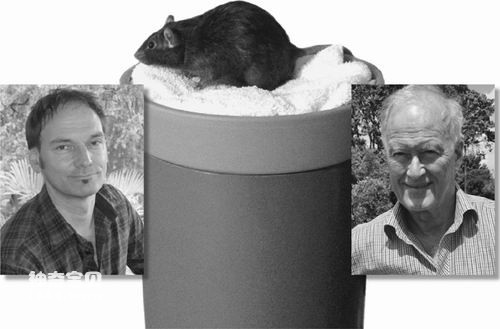Imagine that you are a researcher who conducts an ingenious experiment and uses all your scientific experience to successfully complete the experiment. Many years later your phone rings with congratulations from colleagues because you have just won the Nobel Prize. You fly to Stockholm, Sweden, get on the podium, and the king is waiting for you...
People always imagine this way, using past memories to build a picture of the future, which may never actually come true. Researchers call it mental time travel (MTT), a term coined in the 1990s by psychologists Thomas Suddendorf of the University of Queensland in Australia and Michael Corballis of the University of Auckland in New Zealand. The two believe that MTT, including conscious thought, is unique to humans. They set strict standards for proving that animals share the behavior and insist that it is not encountered even in the most intelligent non-human species.

Michael Corballis (right) thinks mice can perform mental time travel, but Thomas Suddendorf (left) doesn't think so.
Since then, other researchers have conducted hundreds of experiments to try to prove whether animals can also perform MTT - a key to planning for the future. Now, inspired by new research on the mouse brain, Corballis is changing his thinking and perception. Last month, in the journal Trends in Cognitive Science, the still-friendly two began an academic debate. Corballis said the study shows that mice not only repeat maze runs they have run before, but also mentally explore routes they have never walked before - a form of MTT. Suddendorf, on the other hand, stuck to his original view.
Scientists who conduct such studies say that some non-human species must engage in MTT behavior, although there is no way to explain the consciousness of these animals. They say, for example, that birds store food for later and that a chimpanzee named Santino hid rocks to later throw at zoo visitors.
Suddendorf insists that these phenomena are not evidence of MTT. He said animals will have some components of MTT, including the ability to map external physical space in the brain and understand the world around them. "However, MTT does not only include these, MTT will give us the flexibility to imagine any scenarios and future plots, and prepare for unexpected events."
Corballis does not suggest that animals have the same imagination as humans. But he said the MTT behavioral test he and Suddendorf designed—which involves using new questions and single experiments that the animals cannot learn to master—may be too harsh. Corballis said the new mouse study provides "deeper information" about what the animals might be able to do.
Recent research has recorded nerve impulses in the hippocampus of mice as they ran a maze. Corballis said that the hippocampus is a key component of memory storage in humans and animals, "and is critical to human MTT." The groundbreaking experiment was led by neuroscientist A. David Redish of the University of Minnesota-Twin Cities and was reported in 2007.
Researchers published a paper last year in the journal Science supporting this finding. The paper notes that as rats learn a maze, their hippocampal neurons repeat previous routes as well as possible future routes, even when they rest outside the maze. A paper published last month in the journal Science showed that mice use place cells to map out the 3D space they move through.
Corballis believes that more and more research shows that "MTT has ancient origins," but he also admits that human MTT behavior is much more complex. Redish said that despite the "obvious differences" between mice and humans, he "fully believes that MTT behavior exists in animals as well."
Suddendorf countered that mice only have part of the complete MTT. For example, they lack subjective awareness and so-called recursive thought: the ability to combine images and experiences to construct infinite future scenarios (such as winning a Nobel Prize or traveling to outer space).
Some animal behavior experts say nonhuman MTT is real, but for different reasons than Corballis. Mathias Osvath, a primatologist at Lund University in Sweden, says the findings from studies on chimpanzees and birds storing food for later are "more compelling" than the findings in mice. He studied the stone-throwing chimpanzee Santino at Furuvik Zoo. He said these studies prove the existence of MTT. He believes that there is no need to use conscious or fictitious thoughts to prove MTT behavior in animals.
Both sides of the debate have different reasons, which light the way for future research on non-human MTT. Corballis favors neurophysiological studies like the mouse hippocampus study, while Suddendorf believes that if animals do exhibit MTT behavior, it should be checked by "more rigorous" behavioral tests. He and Corballis both agree on a key point: Only through the evolution of language could animals begin to share their MTT stories and actually realize those imagined scenarios.
animal tags:
We created this article in conjunction with AI technology, then made sure it was fact-checked and edited by a Animals Top editor.